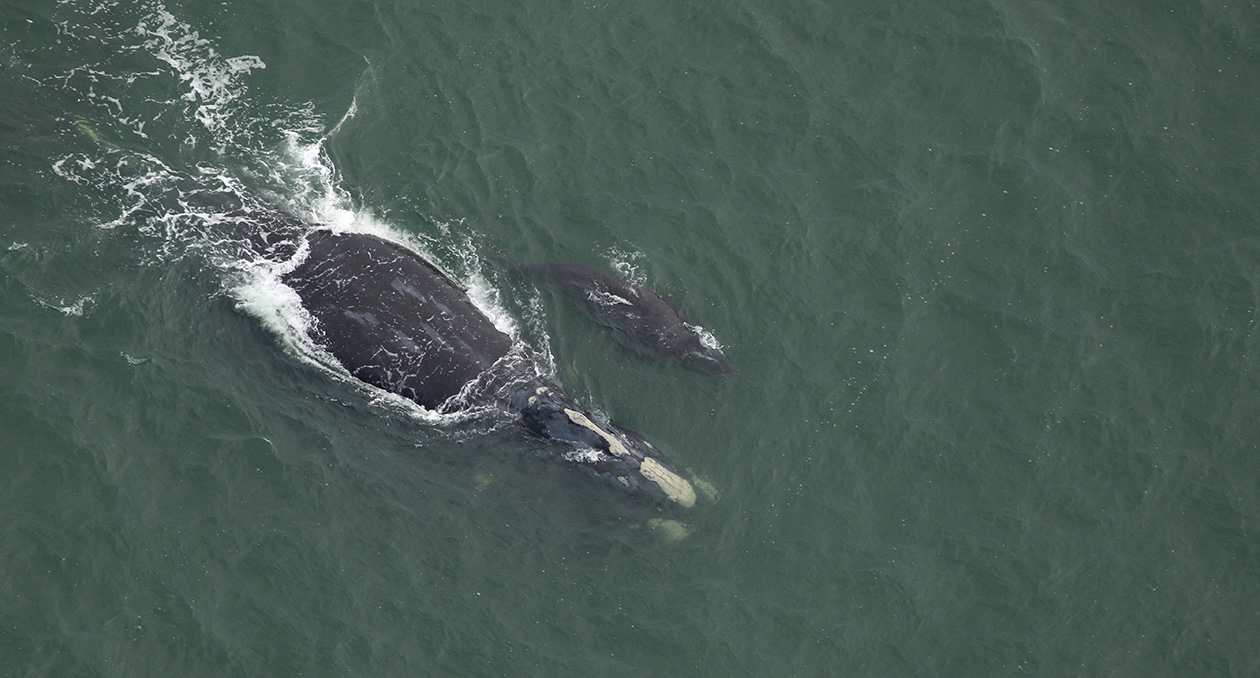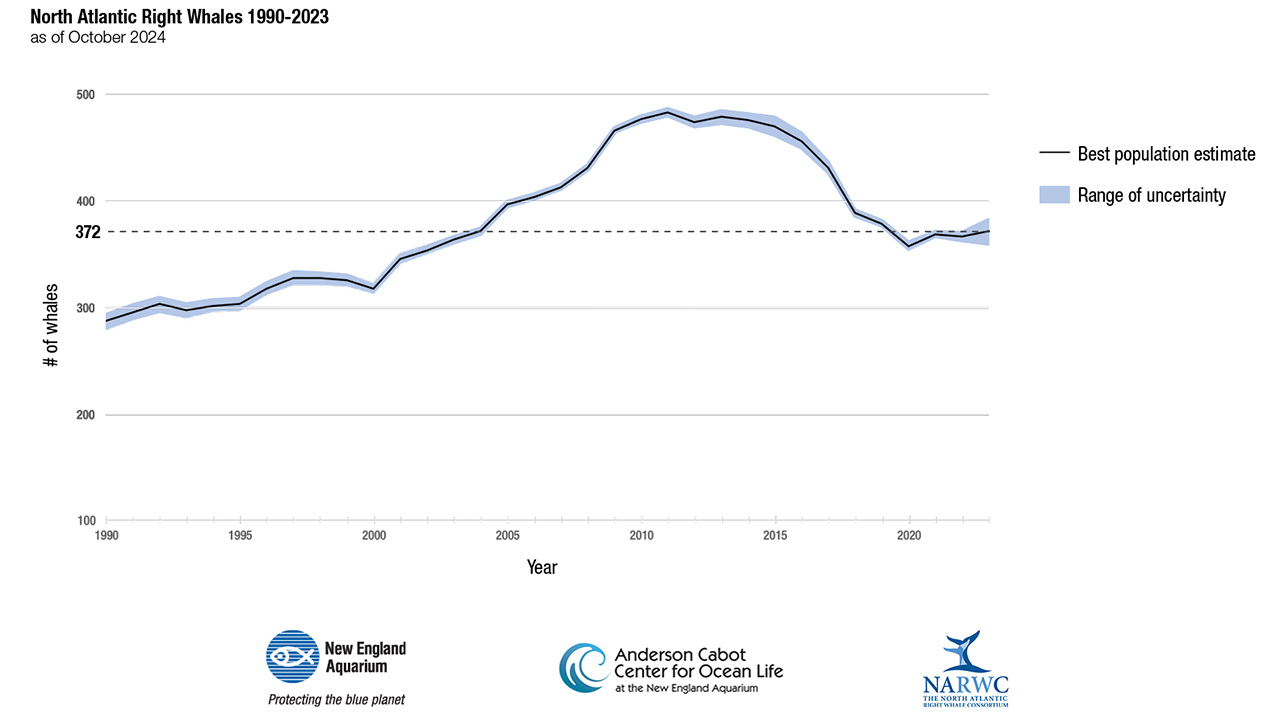Please note: We strongly recommend purchasing tickets in advance to guarantee entry, as we do sell out during school vacation week (April 19 – 27).

BOSTON, MASS. (Oct. 22, 2024) – The North Atlantic right whale population has shown a slight increase in recent years, though scientists emphasize that the critically endangered species still faces significant ongoing threats from human activities.
**PHOTOS AND GRAPHS AVAILABLE FOR DOWNLOAD HERE**
Each year, the North Atlantic Right Whale Consortium releases the annual population estimate for the species using the most up-to-date data, including calves added to the population since the previous year. In a report being released at the Consortium’s annual meeting, October 23–24 in Providence, Rhode Island, scientists used these updated data to calculate annual estimates of the right whale population since 1990. The newly released estimate for 2023 is 372 (+11/-12), including 12 calves of the year. The heartening news is that the trend for this species has shown a slow increase since 2020 when it hit a low of 358. These estimates are the result of a collaboration among scientists from the New England Aquarium’s Anderson Cabot Center for Ocean Life and the National Oceanic and Atmospheric Administration (NOAA). (NOAA plans to post the accompanying tech memo on Oct. 22, available at this link.)
“To see the population estimate increasing gives us hope that what felt like a free fall over the past decade may be behind us,” said Heather Pettis, a research scientist in the Anderson Cabot Center and the chair of the North Atlantic Right Whale Consortium. “While we still have a great deal of work to do to ensure that this species not only recovers but thrives, it feels really good to be able to share a little bit of positive news.”

Scientists are also sharing reports on right whale deaths, entanglements, and vessel strikes at this week’s Consortium meeting and that news is less positive. So far in 2024, there have been five detected right whale deaths and four other lost calves, the highest annual mortality count since 2019. Causes of death were identified as chronic entanglement for one whale and vessel strikes for three. One of the whales could not be retrieved for assessment. These nine deaths may well lower the population estimate for 2024 when that is generated next year.
“While entanglements remain the leading cause of death and injury, this year there were at least six vessel strike-related injuries/deaths, highlighting the importance of addressing this issue soon. The persistent aggregation of more than 50 right whales in the New York shipping lane this summer underscores this even further,” said Pettis.
Several of the 2024 mortalities highlight the nature of human-caused injuries to right whales. A three-year-old female (#5120) who was entangled for more than 17 months was malnourished and had rope deeply embedded in her tail when she was found dead in January 2024. Right whale #1950, a female who was at least 35 years old and had given birth to her sixth calf this year, died from a vessel strike in March 2024. Her dependent calf is presumed dead. And finally, the 2024 calf of right whale “Juno” (#1612) was struck by a vessel sometime between December 9, 2023, and January 3, 2024, and suffered significant propeller cuts to her head. Disfigured and observed bleeding on multiple occasions, the calf was last sighted alive on February 27, 2024. On March 2, 2024, Juno was sighted without her calf, and the calf was found deceased the next day.
In addition to the five documented mortalities and four lost calves, to date, analysis by the Aquarium’s Anderson Cabot Center scientists reveals 13 human-caused injuries to right whales in 2024 that are concerning, including seven fishing gear entanglements with attached gear, four entanglement injuries (with no attached gear), and two vessel strikes.
“After seven years of steady decline from 2013 to 2020, this reversal in the trend of the population over the last few years is welcome news. I wish we could infer that this paints a rosy picture for the future, but the 2024 mortalities and serious injuries are sobering,’” said Philip Hamilton, senior scientist at the New England Aquarium’s Anderson Cabot Center and the identification database curator for the Consortium. “While the whales may be adapting to a rapidly changing environment, the continued high level of mortality and serious injury clearly shows we must continue to adapt and evolve our management.”
Efforts to protect North Atlantic right whales, one of the most endangered large whale species in the world, have involved conservationists, scientists, government agencies, and the fishing and shipping industries from both the United States and Canada. Despite these efforts, entanglements and vessel strikes continue to threaten the survival of the species and additional measures are needed. Advances in ropeless or “on-demand” fishing technology show promise, though widespread implementation will require significant financial support to escalate the manufacturing of the gear and provide training and support for the fishing industry to adopt gear use. NOAA has also been working to develop vessel speed restrictions that better protect North Atlantic right whales while ensuring both the species and economy thrive.
Calving numbers in this decade have improved over those in the 2010s but are still below what scientists saw in the 2000s. This past calving season, 20 calves were born—eight more than last year, but that increase was greatly diminished by the deaths of at least five of those calves by spring. Four of the mothers calved for the first time which is encouraging given that many adult females have been delaying their first calving in recent years.
“The 2024 calving year was an emotional roller coaster ride for those of us in the right whale community, with relatively high numbers of births and deaths. It ended on a high note with a mother named Pico (#3270) detected with a calf in June offshore of Virginia. We approach the upcoming 2025 calving season (starting December 2024) with both excited anticipation and concern. One big question is whether some of the 40+ adult females between the age of 10 and 20 that have delayed giving birth to their first calf will enter the breeding pool,” said Hamilton.
More than 500 in-person and virtual attendees from all over the world are expected for this week’s North Atlantic Right Whale Consortium meeting in Providence. Following the meeting, the Consortium will draft a comprehensive annual report on the status of the species; survey, management, and research activities; and recommendations for action. The report will be available early in 2025 and published on the Consortium website.
MEDIA CONTACT:
Hannah Boutiette – 413-717-7759; hannah@teakmedia.com
Diana Brown McCloy—978-697-9414; diana@teakmedia.com
